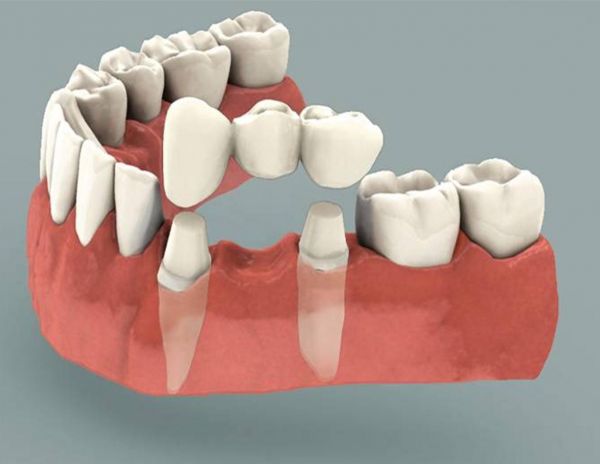
A dental crown, sometimes referred to as a cap, is a covering that goes completely around a tooth. Teeth that are heavily filled or have had root canal treatment are at risk of chipping or fracturing, a crown is used to support these teeth reducing the tooth’s chance of fracturing. Crowns are also used for aesthetic reasons to change the shape or colour of a tooth.
They can be made from various materials but usually from pure porcelain that is fused to a metal substructure, often gold or from porcelain only. The length of time it takes to prepare a tooth for a crown depends on the difficulty of the situation. Usually a minimum of one hour is required in the dental chair. An impression (mould) is taken of the prepared tooth and sent to a Dental Technician who takes approximately two weeks to construct the crown. A temporary crown is made of plastic and is placed on the tooth for this time, so that you can eat properly and the tooth looks normal.
It takes approximately 30 minutes to cement in the new crown on the next visit.
Generally, a crown fails not because there is something wrong with the crown, but usually due to decay in the tooth around the crown or the rest of the mouth changes (such as teeth get darker, but crown stays the same) and this makes the crown stand out or the gum recedes around the crown.Depending on the situation a crown should last for approximately ten years, if the supporting tooth stays healthy. It is important though that you maintain regular dental check ups over this time, because if something starts going wrong with the crown it can more easily be corrected at an early
Gold alloys have been used for many years for the construction of crowns or fixed bridges. They provide excellent, strong, long-lasting service. Two major types of alloys are now available:
Bridges can be used to replace missing teeth if there are teeth on either side of the missing tooth. The two teeth are prepared for crowns, then a dental technician can fabricate a bridge with the missing tooth attached to the two crowns. This is all made in one piece to look like three separate teeth. Depending on the difficulty of the situation it will take a minimum of 90 minutes in a dental chair to prepare the teeth for a bridge. An impression (mould) is taken of the prepared teeth and sent to a Dental Technician.
Two weeks later the dentist takes about 30 minutes to cement in the bridge. Your new bridge should last for approximately ten years as long as the supporting teeth stay healthy.
The patient below presented with a broken down back molar and a missing first molar. This was causing the upper and lower teeth to start drifting apart, changing her bite. This also starts placing more pressure on the front teeth, causing them to wear as they are now used for chewing.
During treatment, the back molar had to be reconstructed to remove all decay and fractures.
The finished outcome shows a bridge in place that connects the missing tooth to the teeth on either side of the gap, restoring the patient’s bite.
a. Metal Alone (high-noble or base metal)
Longevity 20 years to life, gold or “silver colour; moderate-to-high initial cost; may be used in any area where the metal display is not objectionable.
b. Porcelain Fused to Metal
Longevity 10-20 years; tooth-coloured; moderate-to-high initial cost; may be used in any area where extreme stress or grinding habits are not present.
c. Ceramic Non-Metal containing crowns
Longevity 10-20 years; moderate-to-high initial cost; may be used in any area where extreme stress or grinding habits are not present. Used when aesthetics is important. (anything over a three-unit bridge constructed from ceramic alone is not advisable).